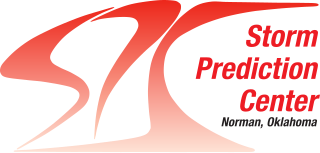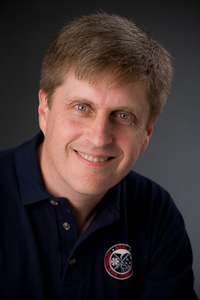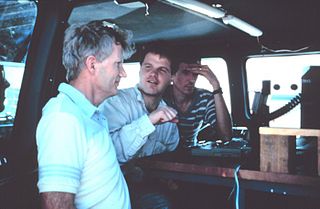
A tornado is a violently rotating column of air that is in contact with both the surface of the Earth and a cumulonimbus cloud or, in rare cases, the base of a cumulus cloud. It is often referred to as a twister, whirlwind or cyclone, although the word cyclone is used in meteorology to name a weather system with a low-pressure area in the center around which, from an observer looking down toward the surface of the Earth, winds blow counterclockwise in the Northern Hemisphere and clockwise in the Southern. Tornadoes come in many shapes and sizes, and they are often visible in the form of a condensation funnel originating from the base of a cumulonimbus cloud, with a cloud of rotating debris and dust beneath it. Most tornadoes have wind speeds less than 180 kilometers per hour, are about 80 meters across, and travel several kilometers before dissipating. The most extreme tornadoes can attain wind speeds of more than 480 kilometers per hour (300 mph), are more than 3 kilometers (2 mi) in diameter, and stay on the ground for more than 100 km (62 mi).
These are some notable tornadoes, tornado outbreaks, and tornado outbreak sequences that have occurred around the globe.
- Exact death and injury counts are not possible; especially for large events and events before 1955.
- Prior to 1950 in the United States, only significant tornadoes are listed for the number of tornadoes in outbreaks.
- Due to increasing detection, particularly in the U.S., numbers of counted tornadoes have increased markedly in recent decades although the number of actual tornadoes and counted significant tornadoes has not. In older events, the number of tornadoes officially counted is likely underestimated.

The Storm Prediction Center (SPC) is a US government agency that is part of the National Centers for Environmental Prediction (NCEP), operating under the control of the National Weather Service (NWS), which in turn is part of the National Oceanic and Atmospheric Administration (NOAA) of the United States Department of Commerce (DoC).
This is a list of meteorology topics. The terms relate to meteorology, the interdisciplinary scientific study of the atmosphere that focuses on weather processes and forecasting.
The National Severe Storms Laboratory (NSSL) is a National Oceanic and Atmospheric Administration (NOAA) weather research laboratory under the Office of Oceanic and Atmospheric Research. It is one of seven NOAA Research Laboratories (RLs).
The Tornado and Storm Research Organisation (TORRO) was founded by Terence Meaden in 1974. Originally called the Tornado Research Organisation, it was expanded in 1982 following the inclusion of the Thunderstorm Census Organisation (TCO) after the death of its founder Morris Bower and his wife. The current Head of TORRO is Paul Knightley, a professional meteorologist.

Tornadoes have been recorded on all continents except Antarctica. They are most common in the middle latitudes where conditions are often favorable for convective storm development. The United States has the most tornadoes of any country, as well as the strongest and most violent tornadoes. A large portion of these tornadoes form in an area of the central United States popularly known as Tornado Alley. Canada experiences the second most tornadoes. Ontario and the prairie provinces see the highest frequency. Other areas of the world that have frequent tornadoes include significant portions of Europe, South Africa, Philippines, Bangladesh, parts of Argentina, Uruguay, and southern and southeastern Brazil, northern Mexico, eastern and western Australia, New Zealand, and far eastern Asia.
Convective storm detection is the meteorological observation, and short-term prediction, of deep moist convection (DMC). DMC describes atmospheric conditions producing single or clusters of large vertical extension clouds ranging from cumulus congestus to cumulonimbus, the latter producing thunderstorms associated with lightning and thunder. Those two types of clouds can produce severe weather at the surface and aloft.

Harold Edward Brooks is an American meteorologist whose research is concentrated on severe convective storms and tornadoes, particularly severe weather climatology, as well as weather forecasting.

The Verification of the Origins of Rotation in Tornadoes Experiment are field experiments that study tornadoes. VORTEX1 was the first time scientists completely researched the entire evolution of a tornado with an array of instrumentation, enabling a greater understanding of the processes involved with tornadogenesis. A violent tornado near Union City, Oklahoma was documented in its entirety by chasers of the Tornado Intercept Project (TIP) in 1973. Their visual observations led to advancement in understanding of tornado structure and life cycles.
The European Storm Forecast Experiment, known as ESTOFEX, is an initiative of a team of European meteorologists, and students in meteorology founded in 2002. It serves as a platform for exchange of knowledge about forecasting severe convective storms in Europe and elsewhere. It is a voluntary organisation and is currently unfunded. It aims to raise awareness and provide real-time education about severe weather forecasting. ESTOFEX issues storm warnings on a daily basis. It also collects reports from the general public about severe convective weather incidents in order to validate its forecasts. Reports should be submitted to the European Severe Weather Database (ESWD).
The following is a glossary of tornado terms. It includes scientific as well as selected informal terminology.

Robert Peter Davies-Jones is a British atmospheric scientist who substantially advanced understanding of supercell and tornado dynamics and of tornadogenesis. A theoretician, he utilized numerical simulations as well as storm chasing field investigations in his work as a longtime research meteorologist at the National Severe Storms Laboratory (NSSL) in Norman, Oklahoma.
The International Fujita scale rates the intensity of tornadoes and other wind events based on the severity of the damage they cause. It is used by the European Severe Storms Laboratory (ESSL) and various other organizations including Deutscher Wetterdienst (DWD) and State Meteorological Agency (AEMET). The scale is intended to be analogous to the Fujita and Enhanced Fujita scales, while being more applicable internationally by accounting for factors such as differences in building codes.






